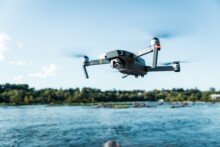Introduction
High-performance drone platforms have revolutionized various industries with their speed, maneuverability, and advanced capabilities. In this article, we will delve into the evolution of drones, their key features, applications, notable brands, and factors to consider when choosing the right platform. Additionally, we will explore the importance of high-performance sensors, advancements in AI integration, regulatory landscape, training and skill development, future trends, challenges, success stories, and the environmental impact of these cutting-edge technologies.
Evolution of Drones
From their humble beginnings as remote-controlled aircraft, drones have come a long way. Initially used primarily for military purposes, drones have now found applications in various industries, including agriculture, photography, delivery services, and more. The technological advancements in materials, batteries, and navigation systems have significantly contributed to the evolution of drones into high-performance platforms.
Key Features
High-performance drone platforms are characterized by their exceptional speed and maneuverability. These drones are designed to achieve remarkable flight capabilities, allowing them to navigate through challenging environments and perform complex tasks. With advanced stabilization systems, high-performance drones can withstand strong winds and maintain stability during flight.
Applications
The applications of high-performance drone platforms are vast and diverse. In the military and defense sector, these drones are used for surveillance, reconnaissance, and target acquisition. Additionally, they play a crucial role in disaster response, search and rescue operations, and border security. In the commercial sector, high-performance drones are utilized for aerial photography, videography, inspection of infrastructure, and even package delivery.
Types of High-performance Drones
One of the most common types of high-performance drones is the fixed-wing drone. These drones resemble miniature airplanes and are capable of long-range flights and high speeds. They are often used in mapping, surveying, and agricultural applications. Other types of high-performance drones include multirotor drones, hybrid drones, and vertical takeoff and landing (VTOL) drones.
Notable Brands
When it comes to high-performance drone platforms, DJI is a prominent brand known for its innovative and reliable products. DJI offers a range of drones with impressive flight capabilities, advanced cameras, and intelligent flight modes. Other notable brands in the industry include Yuneec, Autel Robotics, and Parrot.
Choosing the Right Platform
When selecting a high-performance drone platform, several factors should be considered. These include the intended use, flight time, payload capacity, range, and budget. It is essential to evaluate the specific requirements of the application to ensure the chosen platform meets the necessary criteria.
High-performance Sensors
High-performance sensors are crucial components in drone platforms. They enable accurate navigation, obstacle avoidance, and data collection. These sensors include GPS, altimeters, accelerometers, and gyroscopes. The integration of advanced sensor technologies enhances the overall performance and safety of high-performance drones.
Advancements in AI Integration
The integration of artificial intelligence (AI) in high-performance drone platforms has opened up new possibilities for autonomous flight. AI algorithms enable drones to make real-time decisions, detect and avoid obstacles, and even perform complex tasks without human intervention. This advancement has significantly improved the efficiency and reliability of drone operations.
Regulatory Landscape
As the use of high-performance drones continues to expand, regulatory frameworks have been put in place to ensure safe and responsible operations. Drone regulations vary from country to country, covering aspects such as registration, pilot certification, flight restrictions, and privacy concerns. It is crucial for drone operators to familiarize themselves with the local regulations and adhere to them.
Training and Skill Development
Operating high-performance drones requires specialized skills and knowledge. Pilots need to undergo training and obtain certifications to ensure safe and proficient operations. Training programs cover topics such as flight planning, emergency procedures, airspace regulations, and maintenance. Ongoing skill development is essential to stay updated with the latest technologies and best practices.
Future Trends
The future of high-performance drone platforms looks promising. With the integration of 5G technology, drones will be able to transmit data in real-time, enabling faster and more efficient operations. Additionally, advancements in battery technology will lead to longer flight times and increased payload capacity. The use of drones in industries such as healthcare, construction, and environmental monitoring is also expected to grow.
Challenges in High-performance Drones
While high-performance drones offer numerous benefits, they also face technical challenges. These include battery life limitations, regulatory restrictions, safety concerns, and the need for advanced navigation systems. Overcoming these challenges requires continuous research and development in areas such as battery technology, sense-and-avoid systems, and communication networks.
High-performance Drone Platforms in Medicine
In the field of medicine, high-performance drone platforms have the potential to revolutionize healthcare delivery. They can be used to transport medical supplies, such as vaccines and medications, to remote and inaccessible areas. This technology has the potential to save lives by providing timely and critical healthcare services to underserved populations.
Environmental Impact
Sustainable drone technologies are being developed to minimize the environmental impact of high-performance drones. These technologies include electric propulsion systems, lightweight materials, and efficient battery management. By reducing carbon emissions and noise pollution, high-performance drones contribute to a greener and more sustainable future.
Security Concerns
As high-performance drones become more prevalent, data protection and security concerns arise. Safeguarding sensitive information and preventing unauthorized access to drone systems are essential. Encryption technologies and secure communication protocols play a vital role in ensuring the integrity and privacy of data collected by high-performance drones.
FAQs
Here are 10 potential questions and answers about high-performance drone platforms:
1. What are some of the key factors driving the evolution of drone platforms?
Some key factors driving drone platform evolution include longer flight times, higher payloads, improved sensors and cameras, increased levels of autonomy, and new applications like delivery and inspection.
2. How have battery technologies impacted drone capabilities?
Improvements in battery density, charging rates, and overall capacity have allowed drones to fly longer and lift heavier payloads than what was possible even just a few years ago. Lithium polymer and lithium-ion batteries in particular have drastically improved flight times.
3. What makes a drone platform “high-performance”?
High-performance drone platforms typically have features like extended flight times of 30 minutes or more, ability to carry heavier camera, sensor, and other payloads, advanced stabilization and safety systems, and sophisticated auto pilot modes and navigation.
4. What types of new sensors and cameras are being integrated into the latest drones?
Cutting-edge drones are integrating high-resolution visual, thermal, and multispectral cameras into unified camera rigs. New photogrammetry cameras can quickly map terrain in 3D. Drones also utilize LIDAR, hyperspectral, and other specialty sensors for inspection and survey missions.
5. How has artificial intelligence impacted drone capabilities?
AI is enabling much more autonomous flight, complex navigation, improved computer vision for drone cameras, better payload stabilization, and smarter features like object tracking and automatic return-to-home functionality when difficulties arise.
6. What drone safety features are now industry standards?
Many drones now come standard with obstacle avoidance sensors, automatic return-to-home upon losing connection, parachutes and other emergency measures, and sophisticated flight controllers to stabilize the drone. These help prevent crashes and other issues.
7. What are some emerging civil/commercial uses for advanced drones?
Emerging commercial uses include last-mile delivery, agriculture mapping and analytics, transportation and construction site inspection, surveying and mapping, filmmaking and entertainment, telecommunication platform support, and public safety.
8. What regulatory hurdles still impact widespread drone adoption?
Drone regulation issues like airspace restrictions, pilot certifications, privacy concerns, and a lack of unified global policies continue to slow mainstream integration of drones across many industries and applications. Progress is being made, but slowly.
9. How are high-performance drones helping scientific research?
Drones provide scientists cost-effective aerial survey and sensing capabilities for monitoring environmental changes, tracking wildlife, archaeological surveys, storm analysis, and terrain mapping of volcanic, polar, and other hard to access areas supporting a wide variety of research objectives.
10. How might military and defense applications influence future drone platforms?
Military needs for extended flight durations, secure communications, stealth materials, greater survivability, swarm behaviors, advanced sensors, heavier payloads, and automated target recognition seem likely to eventually trickle down to influence commercial drone platform improvements.
Conclusion
High-performance drone platforms have transformed industries and opened up new possibilities. Their evolution, key features, applications, and future trends demonstrate the immense potential of these technologies. As regulations continue to evolve, and advancements in AI and sensor technologies progress, high-performance drones will continue to play a crucial role in shaping the future of various sectors.

